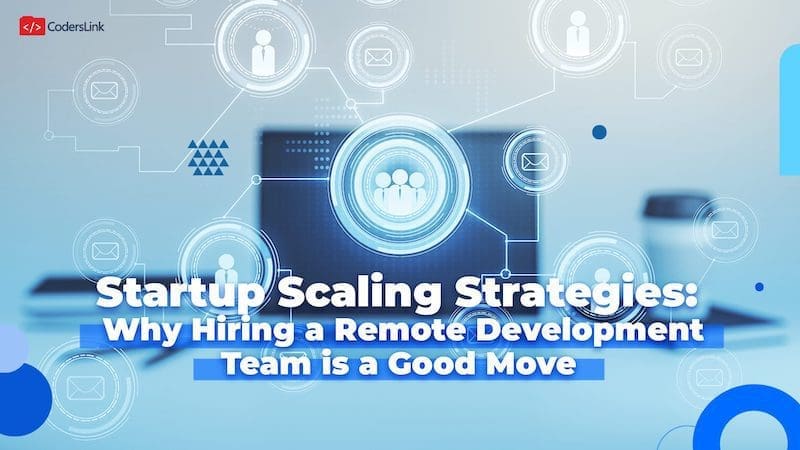
The pressure is on. As a startup, production needs to be efficient, high quality, and fast. Reaching into new talent pools and hiring remote development teams, developers, and tech talent you need might not be the first option that comes to your mind, but here’s how and why it has helped many startups get off the ground and achieve amazing things.
Great products are built by great teams. And great teams are assembled through careful and strategic hiring and management. Today, remote development teams are helping companies grow and innovate. The way we work, however, has changed considerably in the last two years. So, how do companies leverage the possibilities of remote work in their favor?
Let’s take a step back.
The Big Question of Rapid Growth
Rapid growth is every startup’s dream. It suggests the product is ripe in a hot market, but the romantic origin stories of successful companies don’t come with a step-by-step manual for how to handle it. It isn’t easy. The proverbial twenty-somethings tinkering in the garage and becoming the next household name overnight is actually quite a rare occurrence. CB Insights suggests only 1% of startups become known unicorns like Uber, Airbnb, and so on. In fact, a commonly cited statistic is that 9 out of 10 startups fail. In the mid-2000s, reports indicated that venture-backed startups failed at higher numbers than the industry was citing at the time. It has since been common to cite an approximate 75% failure rate for VC-backed startups.
Handling accelerated growth requires strategy, strong leadership, and a little bit of luck. The underlying reasons for failure are multifaceted and multidimensional. They involve a myriad of factors that business experts have tried (but failed) to pinpoint with absolute accuracy.
As a startup ourselves, here’s what we’ve learned from research and our time in the trenches. This limited list doesn’t scratch the surface of the many considerations startups need to weigh in on, but it’s a start.
Here, we focus on considerations related to expanding the team and how building the right partnerships can make all the difference.
The Question of Scaling and Growing Your Team
The scaling phase begins when a company knows they have an opportunity on its hands. This is likely in the form of confirmation that there is product-market fit, but also a possibility for profit. A lot of questions still remain as to how companies get through the scaling phase. There are a myriad of considerations, but thinking about hiring and assembling your team is one major aspect of it.
Pitfall #1 Hiring Too Much Too Fast Without Careful Consideration
Growth can happen quickly, and it often does. However, venture firms are not on the ground of the product creation and development. Investors are hungry for the next big success story. They want to be part of an exciting new venture with promising returns. For companies getting off the ground, an influx of venture capital can be overwhelming and send them to hiring and growing their team exponentially without a clear picture of what the business needs and conserving cash flow. This can lead to over-hiring and committing to big salaries and expenditures the startup may not be ready for.
Pitfall #2 Bad Senior Management and Leadership
Misguided leadership at the top can very quickly nosedive a successful operation. Interestingly enough, there is research that suggests that companies with co-founders fare better than those with one single founder. Like successful rock bands, they may have a front man but there are essential band members that contribute and support. There are, of course, notable exceptions and success stories of companies structured in different ways.
Harvard Business School professor, Noam Wasserman’s research, suggested startups with teams of three seemed to have the highest rates of success. Why? The idea is that teams of three seem to create a trifecta of stability with varying perspectives, diverse viewpoints, and strengths that complement each other.
Pitfall #3 Misreading the Competitive and Economic Landscape
The landscape can change quickly. Innovation moves at a rapid pace and companies should watch the competition and the changing trends of the market to ensure their product doesn’t become irrelevant before it can get off the ground. Understanding what it would take to scale the product beforehand ensures that entrepreneurs are ready to act when the opportunity and funding arise. Without the capability to scale it, it can’t go to market and this might cause delays and even loss of funding.
Pitfall #4 Bad Hiring and Talent Recruitment Practices
At some point in the scaling phase, there will be a need to expand your team. In today’s world, that likely means finding an engineering manager, a tech lead, or software developers to work under your head engineer. If the founders have limited technical expertise, understanding how to structure an engineering team or the requirements of who to hire can create cracks in the foundation. The goal is to stay lean without losing muscle mass. In other words, hiring committed software developers and engineers that are energized about the product and can perform the job.
By carefully calibrating and handling your hiring and talent sourcing, you hire conservatively and you hire well. Mis-hires or over-hiring cause problems down the line and stagger momentum.
Cautionary Tales are a Plenty, Teams are at the Center of Success
There are plenty of cautionary tales that serve as examples for startups on what not to do. In 2017, used car-selling app Beepi had a great idea and appeared to be headed in the right direction. The company, however, had some shaky leadership and was burning through funds by hiring 300 employees, paying overly high salaries and overtime, and spending thousands of dollars on expensive furniture for their offices.
The story of this startup ended badly. The company seemed to lose sight of its mission and focused too aggressively on raising money and meeting higher and higher valuations while problems on the ground and the day-to-day piled up. Add to that the lucrative salaries and office expenses which were not properly accounted for, and there is a recipe for disaster.
IT Outsourcing to Latin America: Rethinking Your Hiring and Expanding Process
During covid, the period of accelerated growth pushed companies into digital transformation. At the same time, remote work rose to prominence out of necessity and, later, out of preference.
We helped many companies find elite tech talent in Mexico and hire remote development teams that contributed to the next stage of the company. Over the years, this included startups that need a small team of remote developers or single developers to support their main engineering staff. Easy Expunctions, for example, worked with CodersLink to support their engineering team at home.
By working with a talent solutions partner, hiring costs are reduced, time-to-hire is minimized, and recruiting efforts are maximized through vetted talent pools. As a growing startup, the right partnerships are essential to improve outcomes.
Learn more about how we foster strong relationships with our talent and hiring companies and improve the process.


